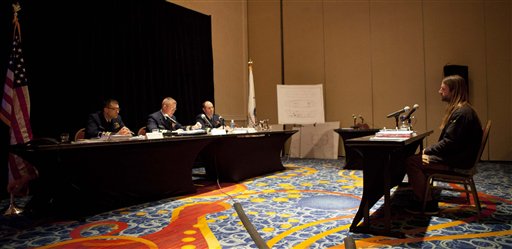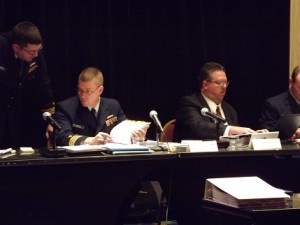Demolition Work Begins On The Francis Scott Key Bridge
by John Konrad (gCaptain) The Unified Command started clearing debris from the Francis Scott Key Bridge collapse today. They did not specify when they will resume the salvage operation for...


John Svendsen testifies at the Bounty hearings in Portsmouth Virginia(AP Photo/The Virginian-Pilot, The’ N. Pham)
What happened to Bounty on the morning of October 29th, 2012? Finding out what went wrong and why, when things happened or didn’t, and who said what to whom – it’s almost impossible. Details have come to light and we’ve learned things, but most of them – all of them really – came from testimony. It’s been eight days of questions and answers, a high stakes game of he said, she said, and none of it really proves anything except that memory is unreliable. The crew has answered questions, but as I look back through my notes on over sixty-four hours of testimony, the three most common answers were “I don’t remember,” “I don’t recall,” and “I wasn’t there.” The Bounty herself – the only real solid evidence in the case – lays silent on the bottom of the ocean.
Throughout the proceedings, Commander Carroll (USCG) and Captain Rob Jones (NTSB) would remind the witnesses of their testimony from interviews they gave last year. Apparently, some stories have changed and memories have faded in the days and months following the accident. Being told that an answer is different from “the last time we spoke” must be unnerving. In one instance an investigator pointed out that a particular witness had said something completely different in their previous testimony; after some stammering, “I don’t remember saying that,” was all the witness could manage. The hearings were rife with contradiction and disconnect. It’s been exhausting.
As a party in interest in the investigation, John Svendsen could ask his own questions of each witness. He appeared to have only one goal: to make sure that witnesses got a chance to say how committed to safety the leadership of Bounty was, and how professional he and Captain Walbridge were. Everyone on the crew seemed to agree. Captain Walbridge and John Svendsen were professional and competent mariners who respected the crew’s opinions, saw everything as a collaborative teaching opportunity, and thought that nothing was more important than safety. Aside from this, agreement was hard to come by.
Some said the bilge system wasn’t working as well as it normally did when leaving Boothbay, others said it was. Some witnesses remembered drills when leaving New London, others didn’t. Walbridge liked to use the starboard generator most of the time, or was it the port? And trying to pin down a time for any significant event can only be done by combining testimony from several crew members, and that will only get you a range. But these disparities are not uncommon in investigations. These differences in their recollections weren’t bothering me, but something was. It was what they weren’t saying.
The crew were being asked to recall the most dramatic and traumatic event of their lives. There is just no way that they didn’t feel it, but none of them would admit to ever being scared. The whole thing, from the capstan meeting in New London where they were given the option to leave, to the donning of survival suits for abandoning ship, was recalled like it was just another day at sea.
No one was scared when the ship started taking on more water than it could pump out. No one was at all worried when the fore course sail blew out. When it took five people to pull Scornavacchi to the deck after a loose sail yanked him high in the 90 mile-per-hour winds, it was described as if they were cleaning up a small paint spill. Every witness spoke of the dangers they encountered in measured tones, like they weren’t even dangers at all.
As the ship heeled over to starboard with the railing in the sea – the crew perched high on anything they could cling to – the answer to, “Was anyone scared? Were you?” was always, “No.” That or, “I don’t remember.” Only one witness – Jessica Hewitt – could recall someone acting frightened, but it wasn’t her. The crew was minimizing everything as not really that big a deal; testimony only became emotional when describing the foundering and then, not consistently.
If you want to see what abnormally cool under enormous pressure looks like, watch Matt Sanders describe his efforts alone and in the dark of the flooding engine room as Bounty sank:
(Matt is tougher than I am. I’ve been on sinking boats – I was scared for my life and it showed.)
Minimization:
Minimizing is what some witnesses do when they experience guilt while answering questions. It’s the difference between a yes or no answer, and one that gives the respondent a way out. Those who were not minimizing their answers had one thing in common: they didn’t work for the HMS Bounty Organization. Kosakowski’s “He was terrified,” and Moreland’s “I can’t imagine,” are clear and definitive answers to questions. They came immediately, without hesitation or preamble. Contrast those answers to Svendsen’s constant, “I would say…,” and “I would answer that,” or Sanders’ “I would say honestly that..,” and, “truthfully, it wasn’t…” responses. Their answers were qualified, often cagey, sometimes non-answer answers:
Jones: “Did Miss Simonin know about the hurricane?”
Svendsen: “I wasn’t there for that meeting.”
Tracy Simonin was the shore side manager of Bounty, the owner’s representative, and hours before they were to cast off lines to head into Sandy, the first mate didn’t know if she knew about the hurricane? He may have, he may not have, but he managed not to answer the question.


The investigators have access to original testimony that many witnesses “don’t remember saying,” and they have a lot of work yet to do. The public hearings are concluded, but the questions will continue to be asked and answered. There are still witnesses left to call and the attorneys will be there as well. Svendsen too may continue to ask his former crew about how good their training was on Bounty and how committed to safety and maintenance they all were. I wonder what they will say?
On the last day of testimony, the last chief mate of Bounty was recalled. The investigators had more questions for Svendsen. He told a slightly different story than he did on the first day. This time, he included details about how strongly he had disagreed with Robin Walbridge in New London:
Svendsen: “I knew the hurricane was there, and I had made my concerns to Robin known, privately, and I had expressed options of staying or looking for another port to seek shelter in. I talked about the option of sailing to Bermuda to use that as safe refuge and, uh, his feeling was that it was time to get underway. And, uh, I asked him how strongly he felt about that – he said, ‘Very strongly, it’s time for us to go.’ I said that I believe the crew should be informed and he held the capstan meeting.”
Jones: “The capstan meeting that was informative but not a discussion?”
Svendsen: “Robin’s capstans are always a discussion. (Svendsen’s next sentence contradicts the first) I believe he opened up with ‘Does anyone want to leave or does anyone have any questions?’ And then he paused and said , ‘OK – we’re going to get underway; cast off lines to get underway.’”
This description of the fateful meeting prior to leaving New London was sounding like less of an option from Walbridge and more like a quick ultimatum; a sort of “Come or go, but I am going.” Everyone – including Svendsen, whose idea the meeting was – stood silent. Though he may have believed the crew should be informed, he didn’t feel that way strongly enough to tell them himself. He wasn’t going to tell his crew that he disagreed with Walbridge, that he thought they should stay in port, that he didn’t believe they should go to sea.
Jones: “Was there any effort made on your part or any other officers to talk to Robin more forcefully, and would he have been receptive if you showed your concerns?”
Svendsen: “I was very assertive in my conversation and he was not receptive to any of the other options.”
Jones: “That seems to contradict a little bit of the testimony that… you received from the witnesses of your crew when you talked to them about all of the teaching that goes on, and all the open discussion, and all the suggestive ideas that [are discussed] on a daily basis. And here, the one time we are talking about a question, he’s not open to any other ideas?”
Svendsen: “My experience of Robin Walbridge is that he was very firm in his ideas.”
Jones then talked about the different testimonies from the crew and how some thought the plan was to go east and around the hurricane, and Svendsen’s testimony that they were headed south by east; that some said they were going to head closer to see what the hurricane would do while others thought they were giving the hurricane more room. Jones wasn’t asking a question, he was just pointing out that the crew’s testimony didn’t line up. Then he stared at Svendsen and waited. What Svendsen said next was the truth:
Svendsen: “I’ll say that everyone has been through a very large trauma and a great loss and as a result of that I’m sure it has affected people’s memories.”
Did we hear the whole truth? Of course we haven’t: Robin Walbridge and Claudene Christian can’t tell us their side of the story, and Mr. Robert Hansen – Bounty’s owner – won’t tell us his.
Join the gCaptain Club for curated content, insider opinions, and vibrant community discussions.


Join the 105,551 members that receive our newsletter.
Have a news tip? Let us know.
Access exclusive insights, engage in vibrant discussions, and gain perspectives from our CEO.
Sign Up




Maritime and offshore news trusted by our 105,551 members delivered daily straight to your inbox.



Essential news coupled with the finest maritime content sourced from across the globe.
Sign Up